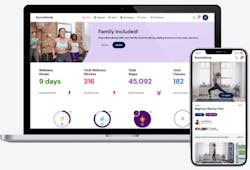Over-the-road truck driver mental wellness, or the lack thereof, has drawn much more attention from numerous programs and industry stakeholders since the pandemic, when isolation—and addictions—were exacerbated to a point where many see other related issues now at crisis levels: lack of sleep; lousy diet and nutrition; rest disrupted by sleep apnea from obesity; and drivers who can’t find ways, places, or time to burn calories and brighten their moods.
Many fleets are introducing increasingly innovative programs to improve driver health and wellness and address issues that can erode them: Estes Express Lines with its promotion of the app-driven Burnalong fitness, health, and well-being platform; the North American Fatigue Management Program; driver retention-focused Supply Chain Fitness; another app-focused “health culture” builder Rolling Strong; comprehensive healthy-eating, exercise, sleep, and well-being program Trucking Along; and Women In Trucking resources aimed at fitness, healthy eating, and safety among the 7% of professional drivers who are female.
One “behavioral economic researcher” who focuses on truck drivers and their wellness issues, Ethan Slaughter, founder of Copeland-Hall Research Institute, and his team of four colleagues are currently conducting a study focused on sleep. It aims to learn just how acute some associated wellness issues among drivers are and how interconnected the trucker’s life and job satisfaction are to problems of depression, poor diet, lack of exercise, and especially sleep problems.
See also: CarriersEdge releases new courses on personal security, mental health
During an interview with FleetOwner, Slaughter spoke about the modern habits drivers appear to have that harm them and their productivity. These include addictions to electronics, food, pornography, online gambling, shopping, or “retail therapy”—often for big-ticket items they can’t afford.
“We are genetically wired for overconsumption, and stress plays a part, especially for truck drivers,” he said.
In addition to speaking to FleetOwner, Slaughter participated in an Aug. 17 Truckload Carriers Association webinar about improving driver mental health. “There’s no bigger issue than driver satisfaction,” Slaughter said during the webinar. “I’m struck by the complexity of the issue of driver dissatisfaction, driven by pay and benefit problems but fed by driver dysfunctions such as poor sleep, isolation, lack of exercise, and poor nutrition.”
He started researching truck drivers about five years ago, conducting a postgraduate study of long-haul truckers and receiving a doctoral award for his work. During the TCA webinar, Slaughter noted that 30% of drivers still abuse drugs, 28% report loneliness, 27% fight depression, and 21% report chronic sleep disturbances.
Driver health and wellness as an economic issue
Slaughter said his research deals with “what economic decisions drivers make that are counterintuitive” to their best interests for the health, wellness, livelihoods, and productivity of their fleet employers. It’s long been known that truck drivers are an overrepresented demographic with obesity, diabetes, and hypertension, “but the connections between driver diet and exercise habits and their ability to perform has been difficult to quantify,” Slaughter said.
In their upcoming study, which Slaughter said will involve 50 to 75 professional drivers, the team of four researchers (one person is a sleep physician, he said) will track perhaps the most critical factor in trucker productivity: sleep quality. “We’re tracking sleep quality in non-invasive ways,” he said.
See also: How one carrier revamped its truck driver health and wellness program
He said the research uses the Oura Ring, a biomedical wearable device, and includes in-cab observation with interventions such as white noise machines and the introduction of custom mattresses as an alternative to standard beds provided by OEMs for sleeper berths.
He added that most industry attention related to problems such as sleep apnea is focused on keeping drivers qualified to perform. (Federal Motor Carrier Safety Administration rules require truckers to have physical exams and hold Form MCSA-5876, their Medical Examiner’s Certificate; sleep apnea is one factor in drivers failing to qualify for these certificates with high blood pressure, epilepsy, narcolepsy, diabetes, heart disease, poor eyesight, loss of feeling or control of extremities, alcoholism, and use of amphetamines, even under a doctor’s supervision.) But more focus, he said, should go toward how sleep problems affect driver quality of life.
Virtually delivered wellness programs for drivers’ mobile lifestyles
All the health and wellness intervention in the world doesn’t matter to drivers if they can’t easily access it on the job from the road. Exercise must be doable at a rest area; alternatives must be available to the typically processed food options at truck stops; diet, exercise, and lifestyle coaching mostly can’t come any other way but virtually; and if mental health intervention is needed, it must be mobile-delivered.
This is where Burnalong and other programs like it come in—and how fleets like Estes Express Lines use app-driven solutions and other worker-assistance offerings to assist Estes’ drivers and other employees needing better rest, exercise, diet, and mental wellness support.
See also: Fit to Pass’ Rebuilt program serves driver recruiting, retention, and health
For Estes, Burnalong offers virtual classes tailored to its drivers, with some recorded and live videos featuring participants in cabs of parked tractors. The app videos and other tutorials cover exercise, diet, stress reduction, meditation, mental health help, depression mitigation, and journaling life experiences on the road. The app offers users access to personal trainers, nutritionists, and other health and wellness professionals. Graf added that therapy for Estes drivers is available outside Burnalong as part of the company’s health benefits package.
“One of the things that came out of the pandemic was tools that we could give them to improve their well-being: physical, mental, financial,” Graf said, adding that Burnalong “has just a lot of different offerings. You can do it in your home or in your vehicle.”
“We’ve had an incredibly robust health and benefits package,” she added. “We’re always looking for ways to support our employees, drivers, and dockworkers.”
Although Graf is not a truck driver for Estes, she uses Burnalong, and the mobile app walked her through “microlearnings” on stress reduction while she waited recently to pick up her daughter from an athletic practice. “By the end of that one, I felt a weight had been lifted off me,” she said.
“Anywhere on the go, our drivers, whether they have two minutes or an hour, can jump in and do a quick course.”
Users of the Burnalong app can personalize it “to create habits they can form, creating a lifestyle that can easily weave into their day-to-day lives and that isn’t so structured where it isn’t realistic,” Graf said, adding that the app offers “little tiny doses of learnings that can compound over time to really make a difference.”
Helping women with their unique diet, fitness, and safety challenges
One group that has emerged as a leading advocate for driver health and wellness is the Women In Trucking Association, which looks after truckers’ safety and well-being for the slice of the female CDL-holder population. WIT runs a blog on all topics related to driver health and wellness.
“It is quite challenging to stay fit while on the road almost every day. Frequent and regular exercise can help both body and mind and reduce the risk of high blood pressure, heart disease, and diabetes. The secret is that the drivers don’t need a full gym or endless hours to remain active. It can seem almost impossible, but many veteran truckers have figured out the tips and tricks to combat the health challenges their job presents,” says a blog post by trucking industry veteran Fran Bernard, who is president of International Trucking School.
See also: Top five health concerns for women truckers
In her post, like others on the WIT site, she offers long-haulers (women and men) common-sense tips on exercise equipment and routines, diet regimens, and even journaling and tricks to maintaining a healthy lifestyle in the cramped and confining environment of the cab of a commercial truck.
This is the second part of a feature on driver health and wellness that appeared in FleetOwner magazine. Look for Part 1 here.








